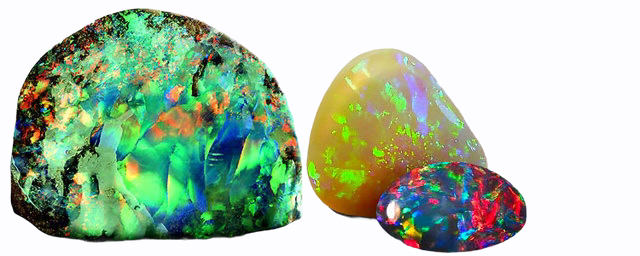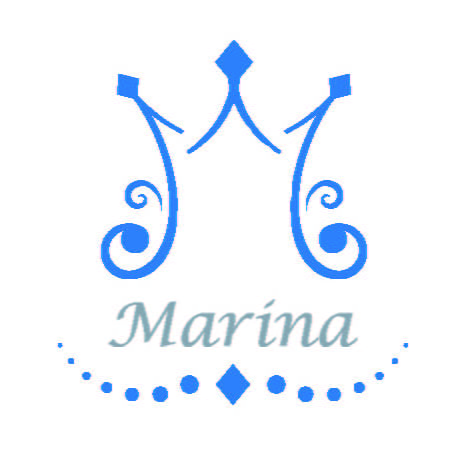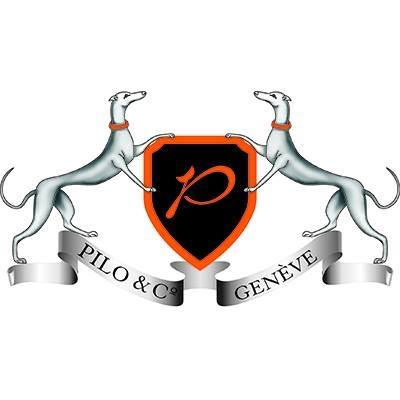Opal History and basic information by Sophy Geneva
Writers have compared opals to volcanoes, galaxies, and fireworks. Admirers gave extraordinary opals poetic names like Pandora, Light of the World, and Empress. In ancient Rome, this gem symbolized love and hope. The Romans gave it a name—opalus—that was synonymous with “precious stone.”
In 75 AD, the Roman scholar Pliny observed, “Some opali carry such a play within them that they equal the deepest and richest colors of painters. Others…simulate the flaming fire of burning sulphur and even the bright blaze of burning oil.” He marveled that this kaleidoscopic gem encompassed the red of ruby, the green of emerald, the yellow of topaz, the blue of sapphire, and the purple of amethyst.
Many cultures have credited opal with supernatural origins and powers. Arabic legends say it falls from the heavens in flashes of lightning. The ancient Greeks believed opals gave their owners the gift of prophecy and guarded them from disease. Europeans have long considered the gem a symbol of hope, purity, and truth.
Opal is considered an October birthstone. Some people think it’s unlucky for anyone born in another month to wear an opal. But that particular superstition comes from a novel written in the 1800s (Anne of Geierstein by Sir Walter Scott), and not from any ancient belief or experience. In fact, throughout most of history, opal has been regarded as the luckiest and most magical of all gems because it can show all colors. Once, it was thought to have the power to preserve the life and color of blond hair. GIA
There are three main aspects of an opal’s quality:
Color—Background color and play-of-color
Pattern—Arrangement of play-of-color
Clarity—Transparency and quantity of inclusions
Color – Background color and play-of-color
OPAL COLORS

An opal might display a single color, two or three colors, or all the colors of the rainbow. Opal displays background color in addition to play-of-color. Background color—also called bodycolor—is caused by the suspension of tiny impurities within opal’s silica spheres. Opals are often divided into types based on background color. Even though there are many different categories for opals, here are the main five types:
Black Opal: All other quality factors being equal, many buyers favor the dark background color of black opal. This is partly because play-of-color tends to stand out attractively against a dark background. The contrast of play-of-color to bodycolor makes black opals very popular. Additionally, black opals are considered to be the rarest (white opals are more common).
White Opal: An opal with a translucent to opaque white and other light color backgrounds (bodycolor) with play-of-color is called white opal.
Fire Opal: Fire opal is transparent to translucent with a bodycolor that is usually yellow, orange or red. This material, which might show play-of-color, is also known in the trade as “Mexican opal” or “Mexican fire opal”.
Boulder Opal : Boulder opal is translucent to opaque opal with play-of-color within a host rock. Thin layers of opal exist within the host rock (called matrix). The opal is cut with the matrix attached and is part of the finished gem.
Boulder Opals
Boulder opals can display intense play-of-color.
Crystal and Water Opal: Crystal opal is transparent to semitransparent with a clear background. This type of opal can show excellent play-of-color. Water opal might or might not display play-of-color. If it does show play-of-color, it is faint and covers only small portions of the gem.
Play-of-color

Play-of-color might be the most spectacular aspect of an opal’s appearance. No matter the color or combination of colors, play-of-color must be vivid to command a high rating. In other words, opal lovers prize bright play-of-color over faint play-of-color.
-Secondary in importance to play-of-color’s strength is its range. If an opal’s play-of-color is not just bright, but also ranges across the entire spectrum, it’s very rare and valuable. Not every precious opal, however, sparkles with every color of the rainbow. In some, the play-of-color consists of just one main color and two or more secondary colors.
Light-colored Opal Beads Desirable play-of-color is further broken down by the colors themselves. Traditionally, red is considered the best prominent color, orange the next most desirable, followed by green. However, favored colors can vary with fashion or personal preference.
In addition, an opal’s play-of-color can change along with the viewing angle or type of light. For example, red might dominate in the same portion of an opal cabochon where blue dominates when it’s viewed from a different angle.
The most valuable opals display play-of-color from all angles.
Pattern—Arrangement of play-of-color
Rare and Common Opal Colour Patterns

Patterns have a huge impact on value and once again, presuming all other factors are equal and the opal has good brightness, a patterned opal would be more valuable than one without any patterns at all.
SMALL-TYPE OPAL PATTERNS
Small-type patterns, for example pin-fire, are less desirable than broad sweeping patterns or large flashes. The larger, more sought-after patterns include straw pattern, Chinese writing pattern, ribbon pattern, harlequin and rolling flashes, because they’re more distinct.
WHAT ARE THE RAREST OPAL PATTERNS?
Starbursts or sunbursts are among the rarest. Other patterns include peacock tail, block, flagstone, jigsaw, stripes, broad flash and fan, to name just a few.
UNIQUE OPALS
Before concluding, some opals have patterns which are one-offs and therefore they’re named accordingly by the owner or retailer, respectively. For example, there is a black Australian opal showing broad flashes which resemble the Sydney Opera House and is therefore named ‘Opera House’ by the retailer, which in this instance was Cody Opal of Australia.
Clarity – Transparency and quantity of inclusions

With an opal, clarity is its degree of transparency and freedom from inclusions. An opal’s clarity can range all the way from completely transparent to opaque. Experts prize different levels of clarity for different opal types. For example, in crystal opal, experts admire transparency, while in black opal they prefer an opaque background. Each provides the best background for displaying play-of-color in its individual opal type. A cloudy or milky background color lowers the value of any opal. It makes the gem less attractive, and it can sometimes signal a lack of stability.
There are various types of opal clarity characteristics that affect value. Opals, like other gems, can have fractures, or pits and other surface blemishes. An opal might also contain fragments of its host rock, called matrix. Matrix in a polished opal is usually—but not always—detrimental to its appearance and value. It depends on the type of opal.
If an opal loses moisture, it can lead to crazing: a fine network of cracks that resembles a spider’s web. The moisture loss can be caused by heat or excessive dryness, or by exposure to bright light or direct sunlight. Crazing can be prevented by never displaying opals in places— such as window displays—where they’re exposed to these conditions.
Even if cracked opals don’t break right away, they have little durability in jewelry, and the fractures spoil the beauty and clarity of the gem. For quality control, producers and dealers single out opals that they suspect might ultimately craze. Dealers who willingly buy crazed opal do so because it commands a lower wholesale price than undamaged opal. This means they can sell it at a lower retail price level.
OPAL CUTTING
The cutter considers an opal’s color, pattern, and clarity when planning the finished gem. As with many top-quality colored stones, exceptional opals might not be cut to standard sizes and shapes.Cutters usually fashion exceptional rubies or sapphires, for example, in a way that saves weight or maximizes color— even if the result is an unevenly proportioned gem. In a similar strategy, opal cutters usually cut top-quality rough to show off its spectacular play-of-color.
To achieve this goal, cutters might fashion fine opals into large, irregular shapes that keep as much play-of-color as possible. Designers set these costly one-of-a-kind gems into custom pieces.
On the other hand, cutters typically fashion commercial-quality white opal and assembled opal into standard calibrated sizes, usually ovals.
The cut of a fine opal should be symmetrical. If it’s a cabochon, the dome should be well rounded. Domed surfaces give the best play-of-color, and make the stone appear vivid from most viewing angles. If the cabochon is flat, it might be vulnerable to breakage, especially during setting into jewelry. If it’s too high, it might be hard to set in jewelry.
Carat Weight
Opals come in a wide range of sizes and carat weights. Opal has relatively low density compared to many other gemstones so even larger sizes can be comfortable to wear.
Common sizes for many of the opal cabochons set in jewelry are 6×4, 7×5, and 8×6 mm.
The Fire of Australia, a large uncut opal, weighs 998 grams or just under 5,000 carats. South Australia is one of the few places on Earth where opals of this size can be found. Approximately 90% of the world’s opals are from Australia.










